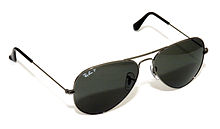Ray-Ban: Difference between revisions
→Entertainment: M Jackson reference is out of place, and has no factual basis. |
|||
| Line 30: | Line 30: | ||
Ray-Ban Sunglasses have made many appearances in Hollywood films. In the 1961 movie ''[[Breakfast at Tiffany's (film)|Breakfast at Tiffany’s]]'' [[Audrey Hepburn]] famously wore Ray-Ban sunglasses. [[Dan Aykroyd]] and [[John Belushi]] also wore Ray-Ban sunglasses in ''[[Blues Brothers]]''. [[Tom Cruise]] also wore Ray-Ban sunglasses in the 1983 film ''[[Risky Business]]'', and the 1986 blockbuster [[Top Gun]]. Ray-Ban sunglasses were also featured prominently in the 1997 film ''[[Men in Black (film)|Men in Black]].'' [[Ben Affleck]] also wore Ray-ban Sunglasses in Daredevil. [[Robert Pattinson]] wears [[Ray-Ban Wayfarer]]s in the film ''[[Twilight (2008 film)|Twilight]].'' |
Ray-Ban Sunglasses have made many appearances in Hollywood films. In the 1961 movie ''[[Breakfast at Tiffany's (film)|Breakfast at Tiffany’s]]'' [[Audrey Hepburn]] famously wore Ray-Ban sunglasses. [[Dan Aykroyd]] and [[John Belushi]] also wore Ray-Ban sunglasses in ''[[Blues Brothers]]''. [[Tom Cruise]] also wore Ray-Ban sunglasses in the 1983 film ''[[Risky Business]]'', and the 1986 blockbuster [[Top Gun]]. Ray-Ban sunglasses were also featured prominently in the 1997 film ''[[Men in Black (film)|Men in Black]].'' [[Ben Affleck]] also wore Ray-ban Sunglasses in Daredevil. [[Robert Pattinson]] wears [[Ray-Ban Wayfarer]]s in the film ''[[Twilight (2008 film)|Twilight]].'' |
||
Also Raoul Duke ([[Johnny Depp]]) in [[Fear and Loathing in Las Vegas (film)]] wore these. [[Johnny Knoxville]], from the [[MTV]] show [[Jackass (TV series)|Jackass]], is also known for usually wearing the mirror-like reflective variety of the Ray-Ban Aviator model. |
Also Raoul Duke ([[Johnny Depp]]) in [[Fear and Loathing in Las Vegas (film)]] wore these. [[Johnny Knoxville]], from the [[MTV]] show [[Jackass (TV series)|Jackass]], is also known for usually wearing the mirror-like reflective variety of the Ray-Ban Aviator model. |
||
[[Michael Jackson]] also made Ray-Ban sunglasses popular during the 1980s and 1990s. |
|||
Other notable celebrities known for wearing Ray-Ban sunglasses in the past include [[Freddie Mercury]], [[Bob Dylan]], [[Joe Strummer]], [[Roy Orbison]], [[Slash (musician)|Slash]], [[James Dean]], [[Hugo Murrell]], and [[Andy Warhol]]. |
Other notable celebrities known for wearing Ray-Ban sunglasses in the past include [[Freddie Mercury]], [[Bob Dylan]], [[Joe Strummer]], [[Roy Orbison]], [[Slash (musician)|Slash]], [[James Dean]], [[Hugo Murrell]], and [[Andy Warhol]]. |
||
Revision as of 23:05, 31 December 2009
This article contains content that is written like an advertisement. |
| File:Logo ray ban.jpg | |
| Company type | Subsidiary of Luxottica Group S.p.a. |
|---|---|
| Founded | 1937 |
| Founder | Bausch & Lomb |
| Headquarters | , |
| Products | High End Eyewear and Sunglasses |
| Website | www.ray-ban.com |
Ray-Ban is a manufacturer of sunglasses, founded in 1937[1] by Bausch & Lomb. They were introduced for the United States Army Air Corps[2]. In 1999, Bausch & Lomb sold the brand to the Italian Luxottica Group for a reported $1.2billion[3].
Ray-Bans were initially created in 1937. Some years earlier, Lieutenant John MacCready had returned from a balloon flying adventure and complained that the sun had done permanent damage to his eyes. He contacted Bausch & Lomb asking them to create a type of sunglasses that would not only provide protection, but also look elegant. On May 7, 1937, Bausch & Lomb officially took out the patent[3]. The prototype, known as Anti-Glare, consisted of an extremely light frame weighing 150 grams. They were made of gold-plated metal with two green lenses made of mineral glass to filter out infrared and ultraviolet rays. Pilots in the United States Army Air Corps immediately adopted the sunglasses[3]. The Ray-Ban Aviator became a well-known style of sunglasses when General Douglas MacArthur landed on the beach in the Philippines in World War II, and photographers snapped several pictures of him wearing them.[3]
Entertainment

(RB3025 004/58)

(RB2132 901L)
Ray-Ban Sunglasses have made many appearances in Hollywood films. In the 1961 movie Breakfast at Tiffany’s Audrey Hepburn famously wore Ray-Ban sunglasses. Dan Aykroyd and John Belushi also wore Ray-Ban sunglasses in Blues Brothers. Tom Cruise also wore Ray-Ban sunglasses in the 1983 film Risky Business, and the 1986 blockbuster Top Gun. Ray-Ban sunglasses were also featured prominently in the 1997 film Men in Black. Ben Affleck also wore Ray-ban Sunglasses in Daredevil. Robert Pattinson wears Ray-Ban Wayfarers in the film Twilight. Also Raoul Duke (Johnny Depp) in Fear and Loathing in Las Vegas (film) wore these. Johnny Knoxville, from the MTV show Jackass, is also known for usually wearing the mirror-like reflective variety of the Ray-Ban Aviator model.
Other notable celebrities known for wearing Ray-Ban sunglasses in the past include Freddie Mercury, Bob Dylan, Joe Strummer, Roy Orbison, Slash, James Dean, Hugo Murrell, and Andy Warhol.
Formula One Sponsorship
In July 2004, Ray-Ban officially became partners with the BAR Honda F1 Team. The Ray-Ban logo was featured in a prominent position on the helmet visors of race drivers Jenson Button, Rubens Barrichello, and third driver Anthony Davidson. For the 2006 season, the distinctive Ray-Ban signature also appeared on the cockpit sides of Honda Racing’s RA106 race car. Honda Racing F1 Team members wore the Ray-Ban 4075 sunglasses model from its spring and summer 2006 sun collection[4].
On April 19, 2009, it was announced that Ray-Ban would continue its sponsorship of the Brawn GP team which was formed following the exit of Honda from Formula One. The distinctive Ray-Ban logo continued to appear on the helmet visors of Brawn GP’s race drivers Jenson Button and Rubens Barrichello since the Chinese Grand Prix weekend. The Brawn GP team members wore Ray-Ban sunglasses from the brand’s 2009 range. [5]
Sundance Film Festival
Ray-Ban has been partnering the annual Sundance Film Festival for independent filmmakers since 2003. Each year, the Ray-Ban Visionary award is given to an individual whose work in the film industry showcases vision, imagination and originality[1]. Previous award winners include Quentin Tarantino, Matt Dillon, Kevin Bacon, Colin Callender and Mark Ordesky[1].
